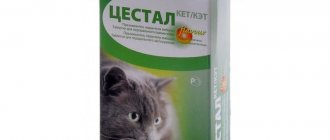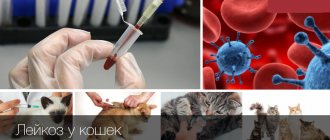Liver diseases are often diagnosed in cats. The main causes of organ damage include an unbalanced diet, long-term use of certain medications, and viral or bacterial infection of the body. With hepatosis, cirrhosis, cholecystitis, cholelithiasis, the digestive and circulatory processes are disrupted, toxins and metabolic products are not removed from the body, and an inflammatory process occurs, which is dangerous for the pet’s life. Therefore, if a cat has a diseased liver, treatment must be started immediately.
Most diseases of the parenchymal organ in cats are accompanied by hepatomegaly - a pathological increase in the size of the liver.
Causes of hepatosis
- The main reason for the development of fatty degeneration is poor quality food. This disease has received especially great development recently. When many owners began to give preference to untested food of dubious quality.
- Molds – they have a toxic effect on the liver in the cat’s body; they can be ingested with spoiled or expired food.
- Obesity – especially liver problems are aggravated in older pets.
- Diabetes.
- Plant poisons (saponins and alkaloids).
- Infectious viral processes in the gastrointestinal tract and general septic processes.
- Liver diseases - cholangitis, blockage of ducts, abnormalities in the development of the portal vein system.
- Pancreatitis.
- Thyroid diseases.
- Lack of vitamin B12.
Most often, the disease is idiopathic (unexplained) in nature. Cats over 10 years old and overweight are exposed to it.
Amyloidosis is systemic in nature and in more than 90% of all cases of the disease occurs in Abyssinian cats. Basically, the disease has a hereditary type of transmission, but it can also develop against the background of inflammatory or proliferative diseases.
Forecast
Experts are convinced that hepatic lipidosis is a dangerous disease in which it is impossible to give an unambiguously positive prognosis for complete recovery. Statistical studies have shown that for every third cat it ends in a fatal outcome. However, 55-60% of sick animals, given that the pathology was detected in a timely manner, respond well to therapy and can live a long, fulfilling life.
The effectiveness of treatment depends not only on the speed of diagnosis, but also on the general condition of the pet, its age, and how well the owners follow the recommendations prescribed by the veterinarian. A kitten and a young animal have a better chance of recovery than an older pet. This is due to the fact that in the latter case, such a disease is aggravated by concomitant ailments, creating certain difficulties in choosing adequate therapeutic measures.
Symptoms of hepatosis
In acute fatty hepatosis, symptoms develop rapidly.
First, the symptom of general intoxication increases - the cat becomes lethargic, has a decreased or absent appetite, and does not show interest in others.
The second symptom is increasing jaundice.
Subsequently, due to an increase in toxic effects on the body and the accumulation of amine, ammonia and bile acids, it leads to hepatic coma.
Fatty hepatosis with a chronic course is characterized by:
- Complete refusal to eat and sudden weight loss.
- Jaundice - clearly manifests itself on the mucous membranes and the inside of the ears.
- Lethargy.
- Digestive disorders - vomiting bile, diarrhea or constipation.
- Salivation.
- Hepatic encephalopathy - when the brain is damaged by toxins, seizures and a general decrease in functioning occur.
- Thinking disorder.
- Ventroflexion of the neck is the inability to raise the head due to muscle weakness.
- Enlarged liver.
Most common liver diseases
The most common liver pathologies in cats include hepatitis, cirrhosis, lymphocytic, neutrophilic cholangitis, which are included in the general group of cholangitis syndrome in cats, cancer and other ailments.
Neutrophilic cholangitis
The pathology is characterized by damage to the bile ducts as a result of infection with pathogenic bacterial flora. Experts suggest that the source of infection is the intestines, but the etiology of the disease is not completely clear.
The disease usually manifests itself acutely - the animal vomits repeatedly, the mucous membranes and skin turn yellow, there is general malaise and signs of intoxication - decreased activity and appetite, a lethargic state.
Young individuals are susceptible to the disease. Treatment leads to complete recovery within one to one and a half weeks. Relapses are observed in rare cases; chronicity of the disease is not typical.
Lymphocytic cholangitis
Unlike neutrophilic, it is not associated with an infectious process. Experts suggest that a disorder of the immune response plays a major role in the pathogenesis of the disease. Most often, middle-aged and elderly animals are susceptible to pathology.
The resulting autoimmune complexes affect the bile ducts, resulting in a gradual increase in liver size, disruption of its function, and accumulation of ascitic fluid in the abdominal cavity. In the terminal stage, the pathological process also involves the liver parenchyma. There are high risks of transition of neutrophilic cholangitis to cirrhosis.
As a rule, animals respond well to treatment, but the course of therapy lasts several weeks. Recovery is often replaced by relapses of the disease and the acute course of neutrophilic cholangitis becomes chronic.
Hepatic lipidosis
Hepatic lipidosis is a disease caused by the deposition of lipids in hepatocytes. Fatty liver is manifested by dyspeptic disorders - nausea, vomiting, stool disorders develop, and the animal refuses to eat for a long time. Jaundice may appear.
Severe liver failure develops in the absence of adequate therapy. In this case, the cat exhibits signs of depression of the central nervous system - behavior changes, lethargy and increased salivation are noted, and an unusual tilt of the head may appear.
The causes of the disease are unknown. In many cases, the development of the disease is preceded by the pet's hunger or stress, intestinal diseases, or inflammation of the pancreas.
Poisoning
Food poisoning, as well as toxic substances, can occur, for example, while walking, when an animal eats food from the ground or from a trash can. Intoxication with salts of heavy metals, industrial compounds and other toxic substances often leads to the formation of hepatitis, cirrhosis and death of the pet.
Hepatitis
Hepatitis is an inflammation of the liver tissue, in which there is no violation of its architectonics. The etiological factor is infectious agents, as well as poisoning by toxic compounds.
Pathogenesis consists of infiltration of the liver with viral metabolites, bacterial waste products or toxins, resulting in local inflammation of the tissue. Massive poisoning can lead to the development of cirrhosis.
Symptoms are usually represented by yellowing of the mucous membranes and skin, nausea, vomiting, abnormal stool, and general poor health of the animal.
Yellow mucous membrane in a cat
Hepatosis
Develops due to the accumulation of lipids in the liver. Hepatosis can occur against the background of existing pancreatitis, cholecystitis and other ailments. Most often, the fatty form occurs, less often - the pigmented form, in which the metabolism of bilirubin is disrupted.
The pet experiences dyspeptic disorders, loss of appetite and weight, and a depressed state.
Cirrhosis
Cirrhosis is a chronic liver disease in which a structural disorder of the organ’s architecture occurs and the formation of regenerated nodes against the background of fibrosis, that is, replacement of the parenchyma with connective tissue. The disease is characterized by a severe course that cannot be treated. As a rule, it develops against the background of hepatitis, which can occur due to a lack of vitamins, poor nutrition, toxin poisoning, the presence of stones in the bile ducts, and helminth infestation.
Symptoms of cirrhosis in cats include signs of intoxication, loss of appetite, ascites, and jaundice. In the terminal stage, liver failure occurs as a result of toxic damage to the brain - the animal can become aggressive, restless, and gait is impaired.
Liver cancer
Cats are susceptible to cancer. Liver cancer often develops. The origin of atypical tumor cells can originate from both the hepatocytes themselves and the bile ducts and other structures of the liver. Most often, malignant liver tumors are metastases, and their introduction is possible both hematogenously and lymphogenously. The disease is characterized by a severe course, ending in death.
Helminthiasis
Helminthiasis is a group of infectious diseases caused by parasitic worms. There are a large number of helminths that can infect the internal organs of cats. The most favorite habitat is the liver. Invasion of an organ by parasites leads to the gradual destruction of its structure. Without taking medications, liver cirrhosis develops. Read the article about deworming cats and kittens.
Infectious diseases
Cats are susceptible to infection by Leptospira bacteria. As a result of infection, leptospirosis develops. The disease affects the liver and other internal organs. Infection occurs through contact with other animals and their biological secretions.
The clinical picture is represented by hepatomegaly, ascites, but, as a rule, there is no jaundice.
Diagnosis of hepatosis
For hepatosis, characteristic changes can be observed even when taking the simplest tests - general blood, urine and biochemistry.
In a general urinalysis, poikilocytosis (altered shape of red blood cells) is observed. Urinalysis shows elevated lipid levels.
In a biochemical blood test, increased levels of liver enzymes (ALT and AST), increased levels of bilirubin and alkaline phosphatase. In case of a dangerous life-threatening condition, a reduced potassium content may be observed.
X-rays are used to diagnose liver enlargement.
For detailed study - ultrasound.
Since with hepatosis it is difficult to distinguish the true cause, a fine-needle biopsy is taken to clarify the type of dystrophy. For accurate diagnosis, before the tissue sampling procedure, vitamin K is given by injection, intramuscularly, at least 12 hours before the start of the procedure.
With liver amyloidosis, inflammatory processes and signs of anemia are often observed in a general blood test. Liver enzymes and bilirubin will be within normal limits. There is an increased protein content in the blood and urine.
If there is pain in the joints, it is imperative to collect synovial fluid in which purulent inflammation can be diagnosed. There is an increased protein content in the cerebral fluid.
Treatment of hepatosis
First of all, in case of hepatosis, dehydration should be removed. To do this, ringer's solution or rheopolyglucin is administered. If vomiting persists, cerucal is recommended (0.5 mg per kilogram once every 8 hours, half an hour before meals).
Be sure to follow a diet. If a cat has anorexia, then forceful tube feeding is used. A nasogastric tube is usually placed. It can then be inserted through the esophagus or directly into the stomach. Owners should offer their cat regular food every day.
The diet should be high in calories and contain large amounts of protein. It is recommended to add vitamins B, E and fish oil.
During tube feeding, arginine must be added to prevent the occurrence of convulsive syndrome.
Lactulose is used as drug therapy, as well as metronidazole at a dosage of 7.5 mg per kilogram every 12 hours.
Amyloidosis is very difficult to treat and owners are immediately warned that a complete cure is impossible. Infusion therapy is mandatory, and in case of acute blood loss - intravenous transfusion.
In rare cases, surgical treatment is used - removal of liver lobes when extensive bleeding occurs.
Drug therapy for amyloidosis - colchicine is given to control the production of amyloid, but can cause side effects - vomiting, bloody diarrhea and suppression of bone marrow function.
Dimethyl sulfoxide - administered as a solution intradermally to dissolve amyloid and have an anti-inflammatory effect.
The veterinarian trains the owner on tube feeding, which can last up to six months, as well as how to care for the cat during treatment. She is recommended complete rest and avoidance of stressful situations.
How the material is taken
When performing a biopsy in dogs, the tissue sample of interest is taken only in a veterinary clinic, in compliance with all sterility requirements. The puncture option may not involve the use of general anesthesia, and only local anesthetic is used for pain relief. To achieve maximum accuracy of all actions, an ultrasound machine is used.
Penetrating through the skin and muscle layer, the needle reaches the affected area of the organ, which the doctor sees on the monitor screen. Sometimes the visual size of the tumor is less than one centimeter, but with the correct selection of the needle this will not be a problem for extracting parts of the tissue.
An excisional biopsy can only be done under general anesthesia, as it involves a full-fledged surgical intervention with tissue excision.
Important! If the animal does not fall asleep, the owner will have to hold it in one position for a long time, which not all pets like. Therefore, when every trip to the veterinary clinic ends with severe stress for the dog, if a biopsy is necessary, it is worth resorting to general rather than local anesthesia.
Complications of hepatosis
Hepatosis is characterized by the development of liver failure and subsequent death. Amyloidosis, when extensive bleeding occurs in cats, often leads to chronic renal failure.
After treatment, infectious processes often develop at the site of insertion of the feeding tube.
Hepatosis is a group of liver diseases that are associated with metabolic disorders and are expressed in tissue degeneration and degeneration of liver cells. The liver is an important protector of our body from toxins and often takes the hit. She can independently regenerate and perform many amazing functions in the body. Dystrophic changes affect the functional activity of the liver, and subsequently lead to its complete degeneration. Hepatosis is similar in nature to an inflammatory disease - hepatitis, but does not have signs of an inflammatory reaction.
Symptoms of the disease
The insidiousness of the disease lies in the fact that in the initial stages it does not have any clear signs. An attentive owner may notice that his pet’s weight has begun to steadily decline, and his appetite has partially or completely disappeared. Over time, symptoms become more pronounced, including:
- lethargy, the cat reluctantly gets up from its place, ignores the owner’s attempts to play with it;
- the skin and mucous membranes turn yellow;
- uncontrollable thirst, even to the point of vomiting;
- constant nausea;
- digestive problems, diarrhea;
- when urinating, the owner may notice that the color of the cat’s urine has become darker;
- copious secretion of saliva in the mouth;
- putrid odor coming from the pet’s mouth;
- the furry pet's muscles atrophy.
In the final stages, manifestations of hepatic encephalopathy and serious disorders associated with the loss of blood clotting ability are possible. These signs seriously threaten the cat’s health and require immediate hospitalization to a veterinary hospital. It is important to understand that prompt diagnosis of lipidosis gives a positive prognosis for healing, since the liver is one of those organs that can recover over time if pathological processes have not affected it too deeply.
Description
About 30% of all diseases (non-contagious) in cats occur in the liver. This is the most important organ that performs a number of vital functions:
- ensuring metabolism;
- removal of toxins, waste, processed products coming from the digestive tract;
- protein and hormone synthesis;
- energy storage in the form of glycogen;
- blood purification.
If the liver is damaged, these functions cannot be fully performed, which causes disruptions in all body systems. Hepatosis is a liver pathology, manifested in metabolic disorders due to tissue degeneration, as well as degeneration or death of cells (hepatocytes). Dystrophic transformations suppress the normal functioning of the liver, leading to its complete degeneration.
Hepatosis is divided into 2 types:
- Fatty degeneration is the degeneration of healthy cells into adipose tissue.
- Amyloidosis is a consequence of impaired metabolism: “harmful” amyloid protein accumulates in the liver. The result is immune pathologies.
Veterinarians more often diagnose problems associated with fatty changes. The disorders occur in acute and chronic forms.
What Research Shows
The results of the studies largely depend on the specific location of the biopsy. Most often, this method is used to determine the nature of neoplasms on the skin, in the intestines, and the condition of the bone marrow, liver and kidneys. Depending on the structure of the tumor and the health characteristics of the pet, the safest type of intervention is selected.
Leather
In case of skin problems, direct indications for the described diagnostic procedure will be vesicular diseases and the appearance of ulcers that are resistant to drug treatment. Before the procedure, the dog’s hair is cut off in the affected areas, after which part of the surface of the wound is excised under local anesthesia. For greater reliability of the results obtained, it is worth taking several samples, not only from vesicles, but also papules, bullae and crusts of dried scales.
A differential diagnosis is made on the basis of laboratory tissue tests and can confirm or refute the presence of malignant/benign neoplasms, various types of mycosis, autoimmune diseases, such as pemphigoid complex and erythema multiforme.
Intestines
If there are problems with the intestines, a direct indication for a biopsy will be protein-losing enteropathy. Usually, for these purposes, diagnostic laparotomy and exploratory biopsy are prescribed in different places of the stomach, intestines and lymph nodes, although in the latter case there is a high risk due to hypoproteinemia. The endoscopic option for performing all actions has lower risks, but the reliability of its results is also lower.
The resulting differential diagnosis of the examination may indicate the presence of lymphosarcoma, autoimmune disorders, and lymphocytic-plasmacytic enteritis.
Important! 2-3 weeks before the procedure, you need to stop giving the dog corticosteroids, otherwise you cannot be sure of the reliability of the results obtained.
Bone marrow
A bone marrow biopsy is prescribed if the veterinarian suspects non-regenerative anemia, persistent thrombocytopenia, or pancytonemia. Preparing the animal for the procedure involves light sedation or local anesthesia, after which the dog is placed with its chest on the table and its paws are pressed. In most cases, a fine-needle aspiration biopsy is recommended, but if the sample is poorly saturated with cells, a trephine biopsy may be used. The puncture is carried out in the iliac crest, and in small dogs - in the acetabulum. The final diagnosis after the examination may be bone marrow oncology or myelodysplasia.
Causes
Saving on quality food, an unbalanced diet, a lack of vitamins and minerals, intoxication and helminth damage - all this causes a strong blow to the liver. Individually or together, these factors suppress the healthy activity of the organ, aggravating the situation and making it susceptible to disease.
Hepatosis in cats is caused by the following reasons:
- intoxication of the body with poisons (especially plant poisons after chewing grass), chemicals, medications (spoilt food with mold fungi getting into the stomach is common);
- sudden changes in diet (for example, a rapid transition from natural products to feed);
- changing the constantly consumed brand of food;
- hypervitaminosis (excess of vitamins, minerals);
- obesity;
- diabetes;
- infectious viral processes in the intestines;
- pancreatitis;
- malfunction of the thyroid gland;
- lack of vitamin B12;
- diseases of the liver, gall bladder (cholangitis, blockage of ducts, pathologies in the portal vein system).
The main place in the list of provoking factors is occupied by low-quality feed. Unscrupulous manufacturers include harmful additives in their ingredients, and buyers, trying to save money, are increasingly buying dubious, untested products.
Fatty degeneration is caused by prolonged fasting, stress, and malignant neoplasms of internal organs. Obese cats over 10 years of age are susceptible to pathology. Hepatosis in young cats is idiopathic in nature, when the exact cause cannot be determined.
Symptoms
The disease is insidious: the initial stages are asymptomatic, and when the clinical picture manifests itself with pronounced symptoms, it is no longer possible to help the cat.
Signs indicating hepatosis:
- decreased/lack of appetite;
- diarrhea, diarrhea/constipation;
- vomit;
- sudden changes in weight (both up and down) with the usual diet;
- yellowness of mucous membranes;
- darkening of urine and feces (even black stools);
- liver enlargement;
- severe itching;
- skin ulcers;
- swelling of the abdomen;
- hair loss, formation of bald patches;
- excessive salivation;
- muscle atrophy;
- bruises on the body due to impaired blood clotting.
The pet's behavior also changes - the cat becomes aggressive or, conversely, depressed and apathetic. At first, the cat drinks a lot of water, sleeps longer, and intestinal upset makes itself felt. The later stages are characterized by yellowing of the mucous membranes, the pet is exhausted, it is no longer possible to save it, and the cat may fall into a coma.
Conclusion
Liver hepatosis is a more than serious disease, which, if not properly treated, can lead to serious complications and ultimately even result in the death of the cat. However, given that this disease develops, as a rule, against the background of infections suffered by the pet or due to improper feeding and maintenance, it is quite easy to prevent. And to do this, you just need to feed and maintain your pet properly, carefully monitor its health, and at the first signs of ill health, contact a specialist.
Diagnosis and treatment
The first step in diagnosing liver diseases in cats: hepatosis and others is a general blood and urine test. The full range of tests consists of a bilirubin test, biochemistry, and liver biopsy. Additionally, ultrasound and x-ray examination of the affected organ are prescribed. In amyloidosis, synovial fluid from infected joints is examined, thereby identifying signs of purulent inflammation.
The disease is serious and requires responsible treatment. It is impossible to restore health using folk remedies alone, but such treatment is allowed along with medications and diet.
Begin by relieving symptoms of dehydration by administering saline, rheopolyglucin, Ringer-Locke solution or other rehydration fluids. If vomiting is present, antiemetic drugs are prescribed (Cerucal 0.5 mg per 1 kg of cat weight before meals every 8 hours).
Hepatosis involves a strict diet rich in protein. If a cat has anorexia, tube feeding is practiced (you should check with your veterinarian about the details for doing it yourself). Initially, a nasogastric tube is installed, then it can be fixed through the esophagus or directly into the stomach. When artificially feeding a cat, Arginine is prescribed against seizures.
A high-calorie diet with plenty of protein is recommended; fish oil and vitamins B and E are introduced into the diet. Natural products of animal origin (low in fat) and ready-made premium-class dietary food are suitable for nutrition. Buy wet types, or soak dry food in water before feeding your cat. This is done so as not to injure the throat and esophagus of a weakened, sick cat.
Feed your cat often (4-5 times a day), in small portions. Make sure that your pet receives at least half the amount of food that he ate before becoming ill. On the first day after an attack, limit the cat’s food intake, feed it porridge with water for a week, and only after that introduce lean meats and minced meat into the diet. A decoction of corn silk has proven itself - a mild choleretic drink. If the pet refuses to drink on its own, give 3 tsp. before every meal.
Lactulose and also Metronidazole are used as drug therapy at a dosage of 7.5 mg per kilogram every 12 hours. For amyloidosis, Colchicine is given to control amyloid production. To dissolve the latter and to relieve inflammation, Dimethyl sulfoxide can be administered. Injections with vitamin C and glucose are administered to relieve symptoms of intoxication. Antispasmodics and antibiotics are prescribed to relieve pain. It rarely comes to surgical intervention. Surgery to remove liver lobes is performed when there is extensive bleeding.
Complications
Many liver diseases in cats: hepatosis, hepatitis and others provoke a number of complications that occur in advanced cases or after improper treatment. Owners of cats with hepatosis face exacerbations of:
- hemorrhage;
- liver and kidney failure;
- infectious processes;
- coma.
Veterinarians say that due to a late appointment, it will not be possible to completely cure the cat; complications may result in death.
Prevention
To prevent the development of a dangerous pathology, control your pet’s diet. Prevent obesity, treat inflammatory diseases in a timely manner. Feed your animals only fresh, high-quality food, “extra”, “premium”, “super-premium” food. Fatty, salty foods, delicacies from our table, and expired foods are prohibited.
Do not neglect preventive vaccinations and dewormings. Strengthen your cat's immune system with vitamin and mineral supplements, especially if the pet is kept on a natural diet.











